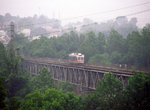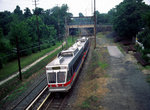SEPTA Rt. 100: Norristown Line
Overview
Route 100, also known as the Norristown High Speed Line (NHSL), or locally still as the "P & W" (from its heritage as the privately owned Philadelphia and Western Railway), is a unique line which has the elements of heavy rail, light rail and commuter rail all wrapped into one. It has the high-level platforms and third-rail contact typical of heavy rail lines, with the closely-spaced stops, on-board fare collection and single-car operation (generally) found on light rail lines, and the general peak direction traffic and suburban setting one would associate with commuter rail.
Station by Station
Route 100 begins at the 69th Street Terminal, where transfers can be made from a host of bus routes in addition to the SEPTA Market-Frankford Elevated and SEPTA Rt. 101/102: Media-Sharon Hill Line. It has a modern 3-track 4-platform terminal at the north side of the complex, adjacent to the El yards. Your typical tour begins on a single-car (two-car trains can be found in peak hours) Adtranz-built "train", one of the 26 delivered in 1994-96. Your run leaves the terminal through a maze of switches, crosses over the leads to the El yards and enters the Victory Avenue complex. A bus garage is on your right, with the Route 100 shops and yards on the left as you proceed from the terminal. A short "platform" exists here for train operators and crews to shuttle back and forth between the shops and the terminal. Some work equipment can usually be spotted in the small yard next to the shop building. When the Bullets and Liberty Liners roamed the line a short time ago, these could also be found resting in the yard. Now, many of these are enjoying retirement in traction museums.
Your car picks up speed through a wooded area surrounded by golf courses and whizzes by the close-in stops, which are infrequently used. Parkview, West Overbrook, and Penfield are the first you pass. After Penfield, the line rises from its at-grade alignment onto an embankment high above the adjacent roadway, when the Beechwood-Brookline stop comes into view. The line drops back to grade for Wynnewood Road, a three-track stop with an island platform between the center and inbound tracks. Some peak hour trips turned back here until the mid-1970's, but no longer.
Most of the stops have been converted from the former wood platform/ waiting shed type to concrete platforms with brick or block shelters. The inbound Wynnewood Road stop still has the wooden building. Inbound cars must load and unload via the left-side doors here. Another feature found at most stations is the stop request light. If a patron wishes to board, he/she pulls a cord on the shelter which illuminates a light on the structure. This also operates a lunar signal just shy of each stop which alerts the train operator that a patron is waiting. A short strip of dummy third rail is provided at each stop, and if a train makes electrical contact, this extinguishes the signal (thus, expresses will not do this).
The line climbs onto an embankment once again, paralleling nearby Haverford Road. Ardmore Junction is next, passing over the former right of way of the Red Arrow's Ardmore trolley line (now paved over for bus operation). After the line drops back down to grade, Ardmore Avenue is the next stop. The line goes dead straight with a small creek on the left for a stretch, with Haverford stop in this segment, then Bryn Mawr.
At Bryn Mawr, another 3-track station is encountered. The center track allows for layovers for Bryn Mawr locals, which alternate with Norristown expresses. An island platform separates the center and inbound tracks, as at Wynnewood Road, and once again, inbound trains must use left-side doors. When expresses operate, these stop only at Ardmore Junction between here and 69th Street.
The route curves away from Haverford Road, into the woods once again, with Rosemont and Garrett Hill quickly passing, then the woods end and the campus of Villanova University approaches. Stadium, the college's athletic field, is quickly followed by Villanova.
Just north of Villanova, beyond the crossover, the line curves sharply eastward. At the curve, the alignment of the former Strafford branch can be seen straight ahead. Although the tracks have been gone for 45 years, the grade is still visible, and a bicycle trail has been proposed for this right of way. Your train vaults over Lancaster Pike (US 30) into the busy Radnor stop. Radnor has become an important reverse commute location, with major employers nearby (among others, TV Guide calls Radnor home). After another quick turn to the right, you pass under the Amtrak Main Line to Harrisburg (where SEPTA's Paoli/Downingtown R5 electric trains run) and begin to parallel I-476 (known locally as the Blue Route) behind the noise wall on your right). County Line stop passes and you cross from Delaware County to Montgomery County as you curve to the left away from the unseen highway.
Taking advantage of geography, your train leaves grade and you find yourself on a high embankment at the Matsonford stop (formerly known as Conshohocken Road, renamed in 1993 at the request of users). Your train continues on a shelf above PA 320 and then takes a gentle "S" curve, ducking under a viaduct carrying I-76 (the locally-famous Schuylkill Expressway) before calling at Gulph Mills stop. Gulph Mills has a sizable parking lot and is quite busy as the main transfer location for bus routes 124 and 125, which continue on to serve the King of Prussia shopping and employment center. As at Radnor, a considerable reverse commute volume is handled here.
After Gulph Mills, the line is back to grade and you enter the speedway portion of the line - almost all straight through to King Manor. Hughes Park stop, lightly used, is usually a blur as trains floor it through this segment. Just past Hughes Park, the ex-Pennsylvania Railroad Trenton Cutoff freight line and the Pennsylvania Turnpike pass over route 100.
King Manor is also a busy stop, with US 202 passing overhead and another chance to connect to a bus for King of Prussia which generates a good passenger count. Past King Manor, the line curves to the right and begins to climb onto an embankment. As Bridgeport stop comes into view, the 2 tracks merge into one (the outbound), with a short stub of inbound track serving for storage. Bridgeport stop is on the left, with outbounds having to use the left-side door this time.
Past Bridgeport, the single-track line curves slightly to the left and then crosses the 3/4 mile viaduct across the Schuylkill River. Downtown Norristown can be seen to the right. At the end of the viaduct, a slight "S" curve brings your train across the ex-Reading freight and passenger tracks (SEPTA's Norristown R6 electric trains operate here) and then onto a 2-track line once again for the short ride into the Norristown Transportation Center. Before the Center opened in 1989, the single-track line continued another block east to Main and Swede Streets. Although the el structure and station are gone, the doors to the former platform can still be seen in the building at the southeast corner of this intersection.
The Center has also allowed some operational flexibility with its 2 tracks. Previously, some trains had to be turned at Bridgeport in peak hours to keep consistent headways on the line. Now, the constraint is not as critical in the line's operation.
The 100 Norristown line generally operates from 5am to 2am every day. Bikes are allowed onboard weedays off-peak, weekends, and holidays. 69th Street, Wynnewood Rd, and Norristown are wheelchair accessible. Weekday peak headways are locals every 15 min, expresses every 15 min, and limiteds every 15 min. Weekday off-peak as well as Saturday headways are 20 min. Sundays are every half-hour.
Fares are pay as you leave outbound, and pay as you enter inbound. Exact change is required and dollar bills are accepted. The fare from 69th to Norristown is currently $2.50, a base fare of $2 plus a 50-cent extra zone charge. This is what SEPTA refers to as its "on board one way cash fare" and includes a minimum 70-cent surcharge vs. prepaid fares. Any railfan interested in riding the line should pre-purchase either a round-trip set of tokens at 2 for $1.30 each, or a Daypass good for all-day riding. Tokens still require the 50-cent additional zone charge for a 2-zone ride, but represents a 70-cent savings over paying cash on board. The fare zones are from 69th to Bryn Mawr and from Norristown to Ardmore Jct. Travel within one of those zones is just the base fare and travel beyond is the base fare plus a zone.
Local trains make all stops while limiteds stop only at 69th, Ardmore Jct, Radnor, Gulph Mills, Hughes Park, King Manor, Bridgeport, and Norristown. There are two types of expresses: express and Hughes Park express. Express trains stop at all stops EXCEPT: Parkview, W Overbrook, Beechwood, Wynnewood, and Haverford. Hughes Park express trains make all local stops EXCEPT: Parkview, W Overbrook, Penfield, and all stops north of Hughes Park.
There are currently plans to extend the line with a branch that would serve King of Prussia and Valley Forge. The branch line would break off at a junction north of Hughes Park and would continue along an existing freight right-of-way to King of Prussia. There would be a new viaduct from King of Prussia to Valley Forge. This viaduct would also carry the proposed Schuylkill Valley Metro and the proposed Cross-County Metro. The four stops would be: King of Prussia; Plaza-Court (serving the King of Prussia Mall); First Avenue; Valley Forge. The Schuylkill Valley Metro would stop at Plaza Court, 1st Av, and Valley Forge (in addition to the many other stops along the Schuylkill River). The Cross-County Metro would serve 1st Av and Valley Forge, in addition to its many other stops.
Roster
Current Roster
| Numbers | Type | Manufacturer | Year Built | Status | Notes |
|---|---|---|---|---|---|
| 130-155 | "N-5" LRV | ABB | 1992-1993 | In service |
Past Roster
| Numbers | Type | Manufacturer | Year Built | Status | Notes |
|---|---|---|---|---|---|
| 160-170 | "Strafford" | J.G. Brill Co. | 1927-1929 | Retired | |
| 200-209 | "Bullet" | J.G. Brill Co. | 1931-1934 | Retired | |
| "Liberty Liner" | St. Louis Car. Co. | Retired | Ex North Shore "Electroliner" | ||
| 476-489 | "CTA 6000 Series" | St. Louis Car Co. | 1951 | Retired | Married pairs. |
Former CTA numbers of the 6000-Series cars used on the Norristown line are as follows: 476-477 x 6069-6070; 478-479 x 6175-6176; 480-481 x 6079-6080; 482-483 x 6089-6090; 484-485 x 6139-6140; 486-487 x 6151-6152; 488-490 x 6162-6163.
Photos
Photo Search
Photo Gallery
| Five Random Images | ||||
 Image 16743 (175k, 1044x705) Photo by: David Pirmann Location: Norristown |  Image 16755 (231k, 1044x702) Photo by: David Pirmann Location: Haverford |  Image 69075 (44k, 930x501) Photo by: Bob Wright Location: 69th Street |  Image 151647 (480k, 1200x800) Photo by: Ralph Curcio Collection of: David Pirmann Location: Hughes Park |  Image 159216 (474k, 1200x800) Collection of: David Pirmann Location: 72nd (69th) St. Yard-Norristown Line |
Photos By Location
Photo locations: 69th Street, 72nd (69th) St. Yard-Norristown Line, Parkview, Township Line Road (West Overbrook), Penfield, Beechwood-Brookline, Wynnewood Road, Ardmore Junction, Ardmore Avenue, Haverford, Bryn Mawr, Rosemont, Garrett Hill, Stadium, Villanova, Radnor, County Line, Matsonford (Conshohocken Road), Gulph Mills, Hughes Park, King Manor, Bridgeport, Schuykill River Trestle, Norristown, Norristown (Original Terminal), Norristown line-Loc. unknown.
More Documents
High-Speed Service Ushers in a New Era on Philadelphia & Western (1931) Design of New Cars with Radical Improvements was a Major Factor in the Extensive Rehabilitation Program. Electric Railway Journal, 1931.
Page Credits
By Bob Wright and Gregory Jordan-Detamore
| ||||||||||||||